TLDR;
This video provides a concise overview of human reproduction, covering both male and female reproductive systems, gametogenesis, menstrual cycle, fertilization, pregnancy, and parturition. It highlights key structures, processes, and hormonal controls involved in reproduction, emphasizing important points for NEET-UG preparation.
- Male and female reproductive systems and their functions
- Gametogenesis in males (spermatogenesis) and females (oogenesis)
- Menstrual cycle phases and hormonal regulation
- Fertilization, implantation, and embryonic development
- Parturition and lactation
Male Reproductive System [0:18]
The male reproductive system consists of primary sex organs (testes) and secondary sex organs, including accessory ducts, glands, and external genitalia. Sexual reproduction involves gamete formation, insemination, fertilization, implantation, gestation, and parturition. Testes are located in the scrotum outside the abdominal cavity to maintain a lower temperature required for spermatogenesis. Each testis contains seminiferous tubules, the site of sperm production, along with Sertoli cells for nourishment and Leydig cells for secreting androgens like testosterone. Accessory glands such as seminal vesicles and bulbourethral glands contribute secretions for lubrication and nourishment of sperm. The sperm pathway includes the epididymis, vas deferens, ejaculatory duct, and urethra, which also carries urine, hence called the urinogenital duct.
Female Reproductive System [3:06]
The female reproductive system includes primary sex organs (ovaries) and accessory structures like fallopian tubes, uterus, vagina, Bartholin's glands, mammary glands, and external genitalia (vulva). The ovaries contain stroma with cortex and medulla regions, where follicles develop. Fallopian tubes consist of infundibulum, ampulla (site of fertilization), and isthmus. The uterus has a fundus, cervix, and cervical canal, which along with the vaginal canal forms the birth canal. The vagina is covered by a hymen, the presence or absence of which is not a reliable indicator of virginity. The uterine wall comprises the perimetrium, myometrium, and endometrium, with the endometrium undergoing changes during the menstrual cycle. External genitalia include the mons pubis, labia majora, labia minora, clitoris, and hymen. Mammary glands contain mammary lobes with alveoli that produce and store milk, which is then secreted through mammary tubules, ducts, ampulla, and lactiferous ducts to the nipple.
Gametogenesis [6:12]
Gametogenesis involves spermatogenesis in males and oogenesis in females. Spermatogenesis starts at puberty, where spermatogonia undergo mitotic and meiotic divisions to form primary spermatocytes, secondary spermatocytes, spermatids, and finally, spermatozoa. Spermiogenesis is the transformation of spermatids into sperm, and spermiation is the release of sperm from Sertoli cells. Hormonal control involves GnRH from the hypothalamus stimulating the anterior pituitary to release FSH and LH. FSH acts on Sertoli cells, while LH stimulates Leydig cells to secrete androgens for spermatogenesis. A sperm consists of a head with a nucleus and acrosome, a neck, a middle piece with mitochondria, and a tail for motility. Oogenesis begins during embryonic development, where oogonia enter meiosis I and arrest at prophase I until puberty. At puberty, primary oocytes complete meiosis I to form a secondary oocyte and a polar body. Meiosis II completes only if the secondary oocyte is fertilized, resulting in an ovum and another polar body. Follicle development includes primary, secondary, and tertiary follicles, with the tertiary follicle containing a fluid-filled antrum.
Menstrual Cycle [10:27]
The menstrual cycle consists of menstrual, proliferative, and secretory phases in the uterus, and follicular, ovulatory, and luteal phases in the ovary. The menstrual phase involves the breakdown of the endometrial lining. The proliferative phase involves the regeneration of the endometrium. The secretory phase involves increased secretion from the endometrium. Follicular development occurs during the follicular phase, followed by ovulation on the 14th day. The remaining granulosa cells form the corpus luteum during the luteal phase. Hormonal regulation involves estrogen secretion by follicles, providing positive feedback to the anterior pituitary, leading to LH and FSH surges. The LH surge triggers ovulation. The corpus luteum secretes progesterone and estrogen, providing negative feedback to reduce LH and FSH levels. A decrease in progesterone levels leads to menstruation. The first menstruation is called menarche, and the last is called menopause.
Fertilization, Implantation and Embryonic Development [12:18]
Fertilization occurs when sperm and ovum are present in the ampulla. The sex of the baby is determined by the sperm carrying either an X or Y chromosome. Upon sperm entry, the zona pellucida hardens to prevent polyspermy. The zygote undergoes cleavage to form a morula (8-16 cell stage), which then develops into a blastocyst with trophoblast and inner cell mass. The blastocyst implants into the uterine wall, leading to pregnancy. The placenta forms after three months and facilitates nutrient and gas exchange between the mother and fetus. The placenta also secretes hormones like hCG, hPL, estrogen, and progesterone. Three germ layers (ectoderm, mesoderm, and endoderm) form, giving rise to all tissues in the developing embryo. The heart develops by the end of the first month, limbs and digits by the end of the second month, and major organ systems by the end of the first trimester. Fetal movement is felt by the fifth month, and the body is covered with hair by the end of the second trimester.
Parturition and Lactation [16:16]
Parturition is triggered by signals from the fully developed fetus and placenta, leading to uterine contractions. Oxytocin release from the maternal pituitary enhances contractions through a positive feedback loop, resulting in the expulsion of the baby through the birth canal. The placenta is also expelled after childbirth. Lactation follows parturition, with the first milk produced being colostrum, rich in IgA antibodies for passive immunity in the newborn.






![[Digimon Podcast] LiT Episode 68 - The Ugly Stick Goes DigiMental](https://wm-img.halpindev.com/p-briefread_c-10_b-10/urlb/aHR0cDovL2ltZy55b3V0dWJlLmNvbS92aS9hRDlVc0hOX29SYy9ocWRlZmF1bHQuanBn.jpg)


